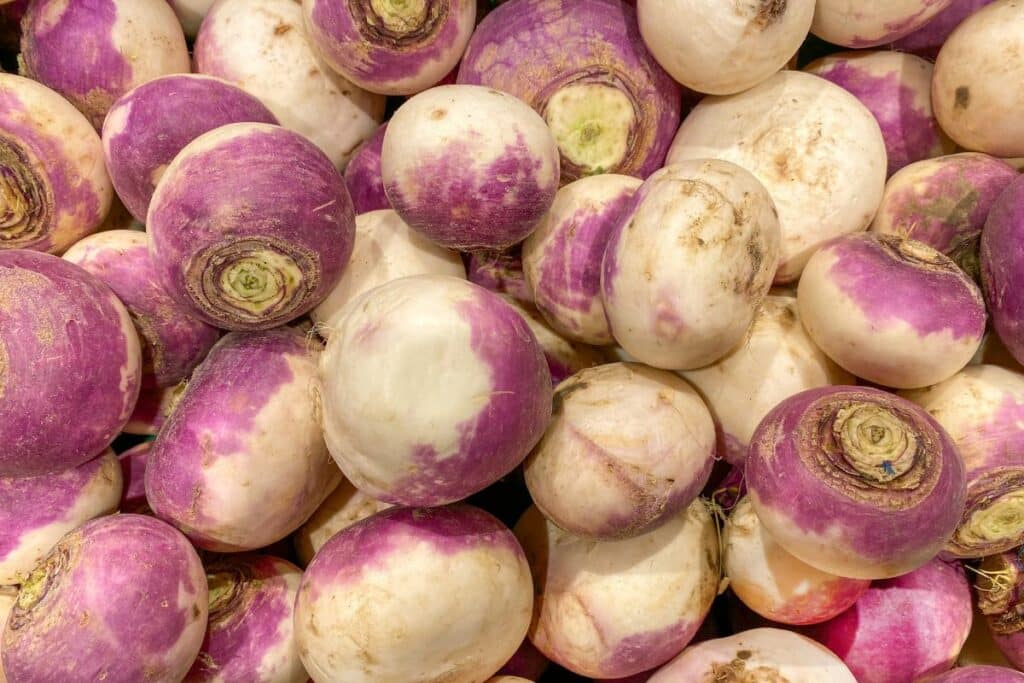Turnips are a popular vegetable and enjoyed by many. They can be roasted, mashed, pickled, or eaten raw.

Despite their negative connotations in the past, turnips are now recognized for their versatility in the kitchen and the benefits they bring to agriculture through crop rotation.
History
The history of turnips can be traced back to Central Asia to 2000 BC, where they were first cultivated.
From here, turnips spread to various European countries, and eventually made their way to the United States.
However, in some parts of the world, turnips were not always seen as a desirable food.
They were primarily eaten by livestock and were associated with poverty. This negative perception was further perpetuated through insults such as “turnip eater”.
Despite these challenges, turnips eventually became a popular food source and were also recognized for their agricultural benefits.
Turnips are able to grow in poor soil conditions, and their deep roots help to break up the soil, making it easier for other crops to grow.
Additionally, turnips were an important crop for crop rotation, which helped to maintain soil fertility.
What Do Turnips Taste Like?
Turnips may not be the most glamorous of root vegetables, but they certainly have their place in the kitchen.
Depending on how you prepare them, turnips can have a variety of flavors and textures and with so many flavor profiles available, turnips are a versatile and delicious addition to any meal.
Let’s take a look at the different types of turnips and their flavors.
Cooked Turnips
When cooked, turnips can take on a sweet and nutty flavor, making them a delicious addition to many dishes.
Unlike raw turnips, their texture becomes soft and velvety, and the taste loses the bitter and earthy flavor commonly found in cruciferous vegetables.
There are various ways to cook turnips, each bringing out different flavors and textures.
Cooking can enhance the natural sweetness and nuttiness of turnips, making them a delicious substitute for white potatoes in many recipes.
Additionally, cooking can help to break down the tough fibers in turnips, making them easier to digest.
Pickled Turnips
Pickled turnips are a popular Middle Eastern condiment that can add a bold and tangy flavor to any dish.
The pickling process gives turnips a unique flavor profile that is both tangy and sour, with a slight salty, peppery, and vinegary taste that is sweeter if young turnips are used.
The texture of pickled turnips is slightly more tender than raw turnips, but they still have a slight crunch that makes them appealing to many people.
The pickling process is what gives pickled turnips their distinct flavor. Pickling involves soaking the turnips in a mixture of vinegar, water, and salt, along with other ingredients to add flavor and depth.
The vinegar acts as a preservative and gives the turnips their tangy flavor, while the salt helps to balance the acidity.
The longer the turnips soak in the pickling brine, the more flavor they will absorb.
If you fancy pickling your own turnips, to enhance the flavor, try using a combination of different kinds of vinegar, such as apple cider vinegar and rice vinegar, and adding minced garlic to the pickled brine before adding the turnips.
For those who love a bit of spice, try adding some chili powder, paprika, or cumin to the mixture. Additionally, letting the turnips marinate longer can help intensify the flavor.
Lastly, adding a bit of sugar can help balance the acidity of the vinegar and give the pickled turnips a slightly sweeter taste.
Roasted Turnips
Roasted turnips have a distinct taste that is quite different from their counterparts.
When cooked in the oven, turnips take on a sweet and tender flavor similar to that of a cooked carrot or potato.
The natural sweetness of turnips is enhanced by the roasting process, which caramelizes their sugars and brings out their unique flavor.
Roasting turnips can also add complexity to their taste by incorporating different seasonings. For instance, drizzling olive oil over turnips before roasting can add a nutty richness to their flavor.
Sprinkling salt and pepper, along with herbs such as rosemary, thyme, and garlic powder can provide additional depth of flavor.
Moreover, using spices like cumin, paprika, and chili powder can give the roasted turnips a bit of heat and earthiness.
The potential for varying flavors and outcomes when roasting turnips is endless. Experimenting with different techniques for roasting turnips can help bring out the most delicious flavor.
What Do Turnip Greens Taste Like?
The taste of turnip greens are reminiscent of the root crop, with peppery notes that give them a spicy kick. However, turnip greens tend to be milder in taste than their namesake vegetables.
When eaten raw, turnip greens have a slightly bitter taste, but cooking them can transform their flavor into something savory and delicious.
To make them easier to eat both raw and cooked, it’s best to remove their stems, which can be tough and fibrous.
In Southern cuisine, turnip greens are a popular ingredient in a variety of dishes, such as salads, stews, and soups. They can also be cooked up with bacon or ham hocks for a hearty, flavorful side dish.
What Are The Different Types Of Turnips?
You may be surprised to know that there are different types of turnips. Each type has its own unique flavor, texture, and appearance.
Whether you’re looking for a sweet and tender turnip or something with a bit more earthiness and bite, there’s sure to be a variety of turnip that meets your needs.
Let’s take a look at some of the different types of turnip.
1. Scarlet Queen Turnips
Scarlet Queen turnips are a unique and visually striking variety of turnip that are a favorite among gardeners and chefs alike.
Their reddish-purple skin and flat shape make them easy to spot in any garden or market.
If you fancy growing some of these nutritious vegetables, they tend to do best when planted in the early spring and harvested when they have reached a size of about 2–3 inches in diameter.
One of the key benefits of growing Scarlet Queen turnips is the burst of color they add to any dish they are added to.
The vibrant pinkish-red color of their skin is not only visually appealing but adds an extra layer of flavor to salads, coleslaw, and other dishes where they can be sliced into thin rounds or shaved into ribbons.
2. Hakurei Turnips
Hakurei Turnips, also known as Tokyo turnips, are a popular variety of turnips that have gained popularity in recent years for their delicate flavor and versatility in Japanese cuisine.
In contrast to regular turnips that can have a slight bitter taste with sweet overtones and are typically eaten raw.
These turnips are small, about the size of a large radish, and have a white bulb with delicate green leaves.
Their small size and mild taste make them a great option for raw consumption, but they can also be roasted, grilled, or sautéed.
In Japanese cuisine, they are commonly pickled or used in hot pot dishes.
If you are interested in trying out unique turnip varieties like Hakurei turnips, specialty grocery stores or farmer’s markets are great places to start.
3. Baby Bunch Turnips
Baby Bunch Turnips are a unique variety of turnips that are harvested early, resulting in their small size and sweet, crisp texture.
These turnips are small and tender, adding a subtle crunch and structure to your salad.
One of the main differences between younger and older turnips is their flavor profiles. Younger turnips have a sweeter and milder flavor.
When it comes to texture, younger turnips are softer and juicier compared to older turnips, which can be drier and denser.
If you’re interested in growing your own turnips, Baby Bunch Turnips are a relatively easy to grow variety.
They thrive in well-drained soil, with partial shade being the optimal conditions for their growth.
Keep in mind that turnips don’t transplant well, so make sure to plant them directly in your garden.
4. Purple-Top White Globe Turnips
Purple-Top White Globe Turnips are a popular turnip variety characterized by their round shape, white flesh, and distinguished purple top.
While their appearance may be similar to other turnip varieties, what sets them apart is their characteristic flavor profile, which is often described as peppery with undertones of sweetness.
In terms of appearance, these turnips are larger than other varieties, taking longer to mature fully.
Their skin is a pale cream color that gradually fades into a deep purple hue on the top. When sliced open, they reveal a crisp, white flesh.
Their unique flavor profile with a peppery taste makes them a versatile ingredient in many dishes, particularly in stews.
Their strong flavor holds up well alongside other bold ingredients, adding depth to the dish.
Moreover, their tough texture makes them ideal for long, slow-cooked stews, since they won’t break down as easily as other vegetables.
5. Milan Turnips
Milan’s turnips are a premium turnip variety that have gained popularity among food enthusiasts in recent years due to their unique taste and texture.
These turnips are known for their buttery flavor and sweet, soft flesh, which sets them apart from other turnips on the market.
Milan’s turnips are small and have a round shape with a smooth, white exterior.
When cooked, their flesh becomes tender and gives off a rich, buttery flavor that is sweet and nutty.
The texture is soft and delicate, making them a perfect addition to soups, stews, or gratins.
Farmers can cultivate Milan turnips using a short cultivation time, which makes them an ideal crop for those who want to grow their own vegetables quickly.
These turnips grow best in cool weather and prefer moist soil. They can also tolerate light frost, which makes them a great candidate for winter gardening.
6. White Egg Turnips
White Egg turnips, also known as Hakurei turnips, are a popular Japanese turnip variety with a unique appearance, texture, and taste.
These turnips have a round, squat shape and a smooth, white exterior. Inside, the flesh is a crisp and juicy white, with a slightly sweet taste and a delicate earthy flavor.
White Egg turnips are perfect for eating raw, as their texture is crispy and refreshing. When cooked, their texture remains crispy and maintains a sweet, nutty flavor with no bitterness.
Their juicy, tender texture also makes them a great addition to hearty stews, as they hold up well during extended cooking times.
White Egg turnips can be enjoyed in a variety of cooking methods. They are delicious when lightly sautéed or roasted, which brings out their natural sweetness and nuttiness.
Steaming them is also a great option, as it preserves their crisp texture while also softening them slightly.
Additionally, they can be pickled for a tangy, flavorful twist.
7. Shogoin Turnip
The Shogoin turnip is a Japanese turnip that was first cultivated in the Shogoin region of Japan in the early 20th century.
It is known for its unique and elongated shape, as it can grow up to 20 inches (ca. 51 cm) in length, and takes longer to mature than regular turnips.
This turnip variety is distinctly different from most turnips due to its bright white roots and lush green leaves.
In Japanese cuisine, the Shogoin turnip is a popular ingredient that is commonly used in stir-fry salads or pickling.
Unlike regular turnips which have a stronger taste and firmer texture, the Shogoin turnip’s texture is softer and the flavor is sweeter.
The turnip’s longer growing cycle allows it to have a more complex flavor profile and a slightly milder taste.
The popularity of this unique turnip extends beyond Japan, as it is now commonly found in specialty markets and high-end restaurants globally.
Turnips Vs. Rutabagas
Turnips and rutabagas are both root vegetables that come from the same family.
They are often used interchangeably in recipes, but there are a few differences to note when it comes to taste.
While both vegetables have a similar flavor profile that can be described as slightly bitter and earthy, rutabagas are known for being slightly sweeter than turnips.
This makes them a great option for those who want a more mild taste in their dishes.
In terms of their physical appearance, turnips are smaller and have a white or purple top and a white flesh on the bottom.
Rutabagas, on the other hand, are larger and have a yellow or brownish top with a yellow flesh.
Turnips are typically harvested when they are small and tender, while rutabagas are left in the ground to grow larger.
As a result, rutabagas have a bit more of a woody texture than turnips.
Both turnips and rutabagas can be used in place of potatoes in many recipes to provide a slightly different flavor profile.
They are delicious roasted or mashed, and can add a unique element to soups and stews. They are also versatile in salads and are often used in root vegetable medleys.
Turnips Vs. Potatoes
When it comes to comparing turnips and potatoes, there are a few key differences to consider.
In terms of taste, as we’ve seen, turnips tend to have a bit of bitterness, while potatoes have a neutral flavor.
However, turnips can be cooked in a way that reduces their bitterness. For example, boiling them with a cut potato can help mellow out their taste.
In terms of nutrients, turnips and potatoes have some differences as well. Turnips are high in vitamin C, while potatoes are higher in vitamin B6.
When it comes to carbohydrates, turnips are actually lower than potatoes, making them a good option for those who are watching their carb intake.
Despite their differences, turnips and potatoes do share some similarities. For example, both vegetables are high in fiber content and are grown in the ground.
They are also both very versatile in the kitchen and can be cooked in a variety of ways.
One interesting aspect of turnips is that they can be used as a substitute for potatoes in many recipes.
For those who are looking to reduce their carb intake or add some variety to their meals, turnips can be mashed, roasted, or used in a root vegetable medley just like potatoes.
This provides a unique flavor profile that can add depth to many dishes.
Conclusion
There we have it, turnips are an incredibly versatile vegetable that can be used in a variety of dishes.
They have a mild, slightly sweet and earthy flavor, making them a great addition to many recipes.
Turnips can be cooked in a variety of ways, from being boiled and mashed to being roasted in the oven or stir-fried.
They can also be eaten raw and are a great source of fiber, vitamins, and minerals.
With so many ways to enjoy them, turnips are sure to be a hit with anyone who gives them a try!






